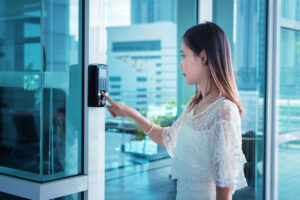Violent attacks have become an epidemic in hospitals, schools and workplaces that were once considered safe spaces. To effectively protect your people from these attacks, you have to manage who is accessing your buildings, how they are getting in, and if they were properly screened for weapons and good health before entering. In this article, we will share with you how the latest innovations in access control systems can keep your staff and patrons safe and healthy while also improving your operations.
6 Access Control System Trends
1. Mobile Credentials
Smartphones and smartwatches can now be used as a credential for entering facilities. A person’s phone or smartwatch replaces legacy keycards/fobs and is what they use to gain access into secure spaces. This approach is a better experience for users and alleviates an organization’s need to constantly replace lost badges. Temporary credentials can also be issued to phones via email for visitors and contractors with set expirations and specific areas assigned for access. Gesture based actions like twisting the phone or double swiping at a door can be used to trigger automatic doors to open without the user having to touch anything besides their own device. Mobile is a true game changer for customer, patient and employee experience in facilities!
2. Integration with Surveillance Systems (Unification)
Surveillance systems and video/audio analytics can now detect potential attacks before they occur. Surveillance systems can identify someone carrying a weapon, making aggressive gestures (punching/shoving), or using threatening language. If the surveillance system is integrated with the access control system, then zones can be locked down automatically to prevent attacks before they happen or at least mitigate their severity. In the past, you had to do custom integrations between systems to make the solutions work together but now you can get systems that are already unified together or use proven integration protocols.
3. Multi-Factor Authentication
Multi-factor authentication is commonly used in the digital space and is quickly moving into the physical access control system arena. This added layer of security is designed to prevent people from gaining access to a facility using a stolen badge and/or pin. The most common multi-factor authentication methods include a biometric credential plus an assigned PIN or a card swipe and an assigned PIN. These multi-factor authentication access control system solutions are typically used in high-security spaces like research labs, data centers, med-rooms, pharmacies, command centers, CEPs and IDFs/MDFs.
4. Cloud-Based Access Control System Platforms
Access control system hardware and servers have traditionally been hosted on-premises. This on-premises system architecture makes system maintenance an inconvenient and slow process without a specialist on your team. With new cloud/subscription-based models, the end-point hardware is still found on-premises but the software and servers are hosted by a manufacturer or managed service provider. This makes server maintenance, updates and repairs much more efficient. There are also other benefits associated with subscription-based systems like low start up costs, scalability, instant updates, multi-facility management, frequent data backups and more.
5. Wearables, Implants, and Tattoos
As important as our smartphones seem to us now, technology has advanced beyond our devices. We are seeing a surge in wearable authentication devices such as smart clothing clips, rings and necklaces. In addition, security access control implants and tattoos are currently being tested and adopted around the world. The possibilities are endless with the smaller chip sizes for today’s credential types.
6. Contactless Access
As COVID-19 continues to reshape our world, we are seeing more organizations leverage biometric features for their access control systems. These systems prevent people from having to touch common surfaces, like door handles, when entering and exiting spaces. The biometric readers recognize a person based on their unique features then grant them access into a facility through an automatic door. This approach makes building access more convenient and secure in addition to helping stop the spread of germs on high-touch surfaces. Facial recognition is the fastest growing biometric authentication method but other options are available such as touchless fingerprints, iris, palm, voice and vein pattern readers.
Your Security Strategy has Never Been More Important
Surges in workplace violence and mass shootings are making the need to improve your security systems more urgent than ever. HSJ works with organizations of all sizes to help solve their biggest security challenges quickly and in the cost-effective manner possible. Whether you need to add new systems or upgrade aging systems already in place, HSJ’s experienced team will guide you through the entire process from assessment, planning, and budgeting on through implementation. Contact our team today to learn more about how we can help make sure you’re doing everything you can to protect your people.





 © 2025 By H. Stephen Jones & Associates, Inc.
© 2025 By H. Stephen Jones & Associates, Inc.